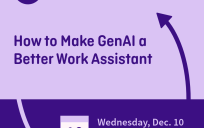 It’s becoming much more common for public sector agencies to talk about customer experience and to define that focus within their organization. Agencies are starting to understand that their customers demand a great experience. While this may seem a challenge to put in place, there are many lessons learned from implementing a solid strategy.
It’s becoming much more common for public sector agencies to talk about customer experience and to define that focus within their organization. Agencies are starting to understand that their customers demand a great experience. While this may seem a challenge to put in place, there are many lessons learned from implementing a solid strategy.
Many would say that agencies do not have competitors, or that others are not trying to steal their market share, yet there are still significant benefits that can be recognized. Results such as enabling employees with a positive engagement model of citizen service, achieving the agency’s mission and reducing costs are top of the list.
Understand the Customer
The first step to implementing a successful customer experience program is to understand the journey of the customers being served. That is, considering the position of the person who is obtaining the service provided and walking step-by-step through what it takes to provide that in a meaningful way. This defines the complete experience customers have with the agency from their perspective. This, of course, demands serious efforts to make sure that the service is being provided through every channel available and in an engaging manner.
When Government takes on the responsibility of providing a customer-focused business, the entire organization starts to think like a customer-driven organization. Often, organizations focus on deliverables such as specific touchpoints or interactions, which means they miss the key component to a successful engagement model. Seeing the journey through the customer’s eyes allows the agency to create an experience that is meaningful and truly customer-centric.
What Do Customers Want?
Consider that the journey provided can last for a very long time, whether through filling out a form, searching for a service on a website, trying to get a marriage license, etc. All of these services require constant engagement between the customer and the agency. By using journey-based thinking, the customer is the main focus of the strategy.
Once the journey has been defined, there should be some measurement of how successful the service is to the customer. In other words, are you on target with the definition of what the customer wants? Continually measuring the success of the interaction means you quickly understand how to refine and improve the process. One thing we know is that customer requirements continually change. Being able to provide measurable metrics of success allows for continual growth and change based on those needs.
Positive, Measurable Results
Creating a positive engagement model that is measurable allows an agency to create the experience customers expect while empowering the agency to be a significant force to the people they serve.
Jennifer McNeill is part of the GovLoop Featured Contributor program, where we feature articles by government voices from all across the country (and world!). To see more Featured Contributor posts, click here.





Leave a Reply
You must be logged in to post a comment.